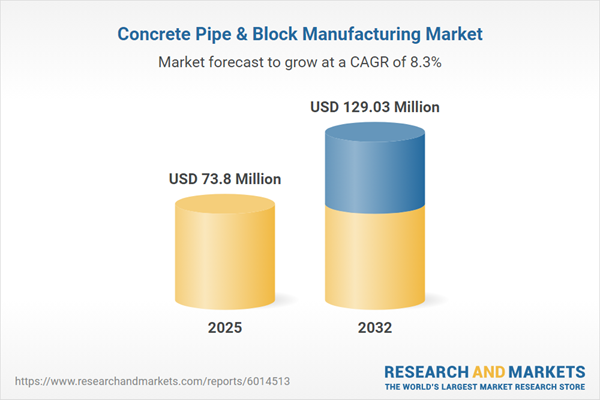Speak directly to the analyst to clarify any post sales queries you may have.
The concrete pipe and block manufacturing market is advancing as senior decision-makers navigate automation, regulatory changes, and supply chain complexity. This report delivers targeted insights, supporting stakeholders in their efforts to sustain compliance, drive operational efficiency, and remain resilient in a competitive, evolving sector.
Market Snapshot: Concrete Pipe & Block Manufacturing Market
Fueled by large-scale infrastructure projects and rapid urbanization, the concrete pipe and block manufacturing market demonstrates stable expansion and sector confidence. A consistent compound annual growth rate highlights robust ongoing investment in public works and construction. Organizations are leveraging digital automation to streamline production, improving product quality while boosting operational efficiency. The introduction of innovative materials and advanced supply chain management has become common, supporting enhanced consistency for municipal infrastructure and sophisticated construction needs. Regional players intensify their focus on modernization and adopt new operational frameworks to expand into international markets, setting elevated standards for sector performance.
Scope & Segmentation: Concrete Pipe & Block Manufacturing
The report is tailored for executives guiding strategy, product development, and regulatory compliance across diverse regional environments. Strategic segmentation details provide executive teams with a comprehensive foundation for agile market entry, effective risk management, and optimized operations.
- Product Types: Hollow blocks, interlocking blocks, lintel blocks, solid blocks, non-reinforced concrete pipes, prestressed pipes, and reinforced concrete pipes, meeting varied structural and functional requirements across projects.
- Applications: Solutions cover drainage, irrigation, partition walls, sewage conveyance, stormwater management, and general wall construction, addressing multiple compliance and project objectives.
- End Users: Serving agriculture, construction contractors, municipal and state agencies, and utility operators, each with distinct priorities for regulatory compliance and operational reliability.
- Manufacturing Processes: Dry cast, spin cast, wet cast, pressure molding, and vibration compaction technologies enhance repeatability and efficiency through increased automation.
- Size Range: Small, medium, and large diameters supplying tailored options for diverse urban and municipal infrastructure demands.
- Key Regions: The Americas, Europe, Middle East, Africa, and Asia-Pacific undergo deep analyses in the report, covering regulatory conditions, raw material sourcing, and strategies for risk mitigation and growth.
- Leading Companies: Includes CRH plc, Heidelberg Materials AG, LafargeHolcim Ltd, Cemex S.A.B. de C.V., Forterra plc, Wienerberger AG, Xella International GmbH, Boral Limited, Buzzi Unicem S.p.A., and Adbri Limited. These profiles allow benchmarking on innovation, process excellence, and market positioning.
Detailed segment coverage empowers organizations to adjust product lines, maximize efficiency, and proactively align with evolving regional and regulatory standards.
Key Takeaways for Senior Decision-Makers
- Investing in digital automation and advanced compaction technology ensures higher production quality while supporting delivery of complex, multi-phase infrastructure portfolios.
- Incorporating sustainable admixtures and low-carbon cement strategies helps maintain compliance and establishes an environmentally responsible reputation amid changing regulatory expectations.
- Strengthening local sourcing and efficient inventory management enhances operational flexibility, facilitating adaptation to regulatory changes and market shifts with minimal disruption.
- Applying tailored reinforcement solutions fosters alignment with client specifications and promotes greater collaboration among stakeholders throughout project cycles.
- Deploying integrated digital platforms across manufacturing and logistics improves process efficiency, helps sustain regulatory adherence, and streamlines communication throughout extensive supply chains.
- Driving infrastructure upgrades, especially in emerging regions, allows for the deployment of advanced manufacturing technology and supports differentiation strategies in expanding markets.
Tariff Impact: Navigating a Dynamic Trade Landscape
Recent trade policy changes in the United States have introduced volatility to raw material supply for aggregates, cement, and reinforcement. Leaders in the industry mitigate risks by reinforcing local sourcing, tightening inventory strategies, and increasing supply chain agility. These initiatives are essential for cost control and ensure operational continuity as trade conditions evolve.
Methodology & Data Sources
The research approach integrates firsthand interviews with senior executives and plant managers, as well as feedback from procurement leaders and authoritative industry sources. Rigorous independent peer review upholds data quality, supporting decision-makers with evidence-based, actionable guidance.
Why This Concrete Pipe & Block Manufacturing Market Report Matters
- Provides in-depth analysis of supply chain management, technological advancements, and sustainability dynamics shaping the concrete pipe and block manufacturing sector.
- Delivers competitive benchmarking and actionable insights, helping senior teams enhance operational processes and market positioning.
- Equips leadership to efficiently manage compliance risks and identify growth opportunities across shifting regional markets.
Conclusion
This report offers executives a foundation for innovation, effective risk mitigation, and sustained operational excellence in the evolving concrete pipe and block manufacturing industry.
Additional Product Information:
- Purchase of this report includes 1 year online access with quarterly updates.
- This report can be updated on request. Please contact our Customer Experience team using the Ask a Question widget on our website.
Table of Contents
3. Executive Summary
4. Market Overview
7. Cumulative Impact of Artificial Intelligence 2025
Companies Mentioned
The companies profiled in this Concrete Pipe & Block Manufacturing market report include:- CRH PLC
- Heidelberg Materials AG
- LafargeHolcim Ltd
- Cemex S.A.B. de C.V.
- Forterra PLC
- Wienerberger AG
- Xella International GmbH
- Boral Limited
- Buzzi Unicem S.p.A.
- Adbri Limited
Table Information
| Report Attribute | Details |
|---|---|
| No. of Pages | 195 |
| Published | November 2025 |
| Forecast Period | 2025 - 2032 |
| Estimated Market Value ( USD | $ 73.8 Million |
| Forecasted Market Value ( USD | $ 129.03 Million |
| Compound Annual Growth Rate | 8.3% |
| Regions Covered | Global |
| No. of Companies Mentioned | 11 |









